Charles F. Wallick - 87th Indiana Infantry, Co. C
Rank: Private, promoted to 4th Corporal
Place of enlistment: Peru, Miami County, Indiana
Mustered into Federal service: August 31, 1862
Service Time: 2 years, 10 months, 23 days
Born: 1843/44 -Miami County, Indiana
Age at enlistment: 19
Height: 5'7" dark hair, blue eyes
Civilian occupation: Miller
Family Lineage
Charles, son of Benjamin Jr., son of "Peru" Benjamin., son of Johannes, son of Hans Michael and Esther Wallick
Charles Fletcher Wallick was one of three brothers from the Benjamin Wallick clan who served in the Federal Army during the American Civil War. He was a younger brother to William Wallick (who became famous by escaping from Libby Prison) and twin brother to John Wesley Wallick, another Civil War volunteer. All three brothers enlisted in Peru, Indiana, with eldest sibling, William, being the first to join in 1861, followed by Charles in 1862 and John Wesley in 1864. Even their father, Benjamin, was mustered into Federal service for a brief period during the summer of 1863. No other single Wallick family contributed more manpower to our country's war effort than Benjamin Wallick's family.
Benjamin Wallick (1804-1884) was born, raised and learned carpentry in Tuscarawas County, Ohio. In 1841 he decided to uproot his young family and start a new life further west in Miami County, Indiana (William was born in Ohio but the twins, Charles and John Wesley, were born in Indiana). Benjamin built and operated for many years a very successful sawmill on Little Pike Creek with all three boys at one time or another working for their father. When Charles returned home from the war he worked briefly for the local railroad but by 1880 was back at his father's mill .
Although the quality is poor, this is the only picture known to exist of Charles F. Wallick and his twin brother, John Wesley. Also pictured is Charles' mother, Eliza, standing in the doorway and Wesley's wife, Rebecca, standing by the fence. The picture was taken at the Benjamin Wallick homestead on Little Pipe Creek in Miami County, Indiana c. 1879. Benjamin built the home in 1853 and was the father of twin brothers Charles and John Wesley Wallick.
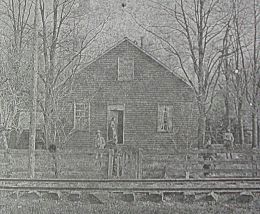

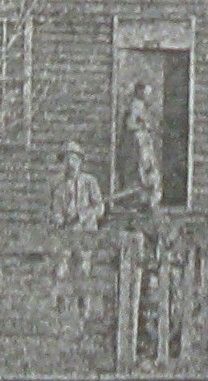
From left to right: John Wesley Wallick, his mother Eliza, his wife Rebecca and Charles F. Wallick holding his rifle.
The 87th Indiana Infantry Regiment was organized in South Bend, Indiana, on August 28, 1862. It was mustered into Federal service on August 31st with 945 men. With the eventual addition of 317 more recruits and replacements, 1262 soldiers served in the regiment over the course of its three-year history. The regiment's first major engagement was with General Buell at the Battle of Perryville in October of 1862. Then on September 19 and 20, 1863, the regiment fought heroically at the Battle of Chickamauga, where over fifty-percent of its men became casualties (Charles was one of them with a bullet wound to his left hand). In May, 1864, the regiment chased Confederate General Joseph Johnston through the hills of northern Georgia and eventually captured Atlanta. Charles then took part in General Sherman’s “March to the Sea", bringing the war to the civilians in the heartland of the South. The regiment stayed in Savannah for two months to resupply and then moved up through South Carolina, where they created more havoc and destruction there than in their march through Georgia.
Charles and his regiment were part of General Sherman's Pioneer Corps, which became legendary in their march through the Carolinas. Comprised of lumbermen from Michigan and rail-splitters from Illinois and Indiana, the Pioneers corduroyed roads, built bridges, and forded rivers. The corps allowed Union forces, with 2500 wagons and 600 ambulances, to move at the rate of twelve miles a day. (Much of the 87th Regiment's responsibility at this time was guarding and helping to move the wagon trains). Such a rapid pace through the Carolina swamps in the middle of winter was thought to be impossible. Once through the Carolinas the regiment moved up to Richmond, Virginia, and then on to Washington D.C., where it participated in General Sherman’s Grand Review of the Western Army. Finally, on June 21, 1865, the 87th Indiana Infantry was mustered-out of service in Indianapolis with only 313 of the original 945 members remaining (Charles Wallick being one of them).
We know a great deal about the wartime experiences of William and Charles Wallick because both served in famous regiments that documented their adventures in post-war histories and each brother kept a diary while serving with his regiment or, in William's case, while a prisoner-of-war. Charles' original diary has been lost with the passing of time but a partial transcript has survived and can be read at the Miami County Historical Society's Museum in Peru, Indiana. Although his diary is incomplete, it does contain daily entries about his regiment fighting its way through northern Georgia to Atlanta and its march of destruction from Savannah through the Carolinas. Excerpts from his diary will be included in the chronology of regimental events.
There were two Charles Wallicks who served in the American Civil War, one from Indiana and one from Ohio. The one here, Charles F. Wallick, served with the 87th Indiana Infantry. The other Charles Wallick (his comrades called him Charley) served in the 16th Ohio Infantry. To avoid confusion, in their biographies the Ohio soldier will be referred to as Charley and the Indiana soldier as Charles.
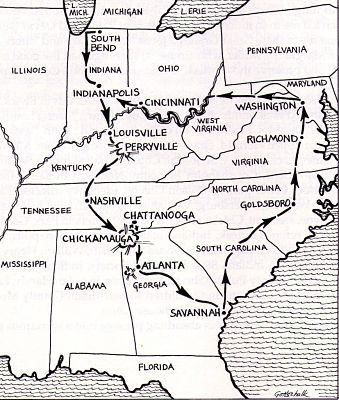
Journey of the 87th Infantry in the Civil War
Map from A Stupendous Effort by Jack Overmyer
Charles Wallick with the 87th Indiana Volunteer Infantry
1862
AUG 31 The 87th Indiana Infantry is mustered into federal service and ordered to Louisville, KY.
SEP The regiment pursues Confederate General Bragg in KY, and is posted in the Louisville area. Here they help defend the threatened city.
OCT 8 Battle of Perryville. Charles and the 87th experience their first taste of battle at Perryville, KY. The regiment is hastily marched onto the battlefield at the close of the day to reinforce a Union Army that is in serious trouble. The 87th is the last regiment in their brigade to arrive and nearly cause a catastrophe in this, their first major engagement. Darkness is falling and the regiment is anxious as they march through woods behind the 2nd Minnesota and go into battle formation. The 87th is anticipating an encounter with the enemy at any moment and seeing dark sillohuettes before them, they cock their muskets, ready to fire. The sound of the muskets alerts of the Minnesotans, who suddenly realized they are about to be shot in the back by their own men. Colonel Judson Bishop of the 2nd Minnesota later said, "A prompt and vigorous introduction of the two regiments by name probably saved us from what would have been a sad misfortune." He added that "we had no experience in the whole war so startling as the cocking of muskets behind us."
Once in line the 87th is ordered to lie down near the edge of the woods on the terraced-like ground and not fire until the enemy is positively identified. The order to fire never needs to be given. Though they fail to be harassed by infantry, three Rebel batteries do locate them and commence fire. The cannon shells are "deathly music... some sounded like a threshing machine cylinder when they went through the air and the (walnut-sized) grape shot sounded like hail in the trees and leaves," wrote a 2nd Minnesota corporal. Amazingly, there are only two men from the 87th Indiana who are wounded. Later that evening the regiment moves forward and becomes the lead unit in the line of battle in anticipation of an early morning attack.. The night is chilly and they sleep with their arms on the battlefield. There is good reason for a renewed Confederate attack in the morning, for the Rebels have out-fought the Federals, who's army is at least a third larger. Over 7,600 men have fallen, 4,200 Union verses 3,400 Confederate. But General Bragg, commander of the Confederate forces, decides to retreat in the face of being vastly outnumbered. Perryville is a strategic defeat for the Confederates as this engagement forces them to withdraw from the state of Kentucky.
NOV 15 After ten weeks in the field only 400 men are listed “effective for duty” due to illness and the hardships of a soldier’s life. This is less than half their enlistment strength.
DEC 14 Only 200 present for roll call. They left South Bend, IN, on August 31, with 945 men. Disease caused twice as many deaths as those killed in battle during the Civil War.
DEC 31 Battle of Stone’s River. Part of Charles’ division was at this battle, however, Charles and his brigade were near Gallatin. TN, guarding the Louisville & Nashville Railroad.
1863
JAN - MAR Duty in middle Tennessee.
MAR 5 Charles is involved in a raid at Columbia, TN, against General Nathan Bedford Forrest’s famed cavalry.
JUN 23 The Union Army begins their Tullahoma Campaign in middle-Tennessee by starting over the Cumberland Mountains toward Chattanooga, TN.
JUL - AUG The 87th maneuvers through the Cumberland Mountains to reach Chattanooga. It is slow going through the valleys and over the dangerous mountain roads.
SEP 12 They arrive at Chickamauga Creek, an Indian name that means “River of Death.”
SEP 19 – 20 Battle of Chickamauga. Chickamauga is the bloodiest battle for the western armies and the worse two-day loss of life in the entire Civil War. On the first morning of battle the 87th turns away three fierce assaults by the Confederates. They are then ordered about the battlefield throughout the day and continue to engage the enemy in heavy fighting. The regiment bivouacs without fires on the first evening of battle and resumes their stubborn defensive line the next morning at Kelly Field. Distant cousins, Levi Wallick, of the 44th Indiana and Isaiah Wallick, of the 49th Ohio, are also heavily engaged at Chickamauga and, they too, see action on or near Kelly Field. By the afternoon of the second day the Union Army is in serious trouble, being overwhelmed on the battlefield by the Rebel forces. The 87th makes a remarkable stand with the 49th Ohio and 44th Indiana on Horseshoe Ridge in order to provide a safe withdrawal of Union forces from the battlefield. This hotly contested late-afternoon fight helps avoid a Federal rout and makes possible an orderly retreat back to Chattanooga. The field commander on Horseshoe Ridge, General George Thomas, is awarded the moniker "The Rock of Chickamauga" due to his supreme efforts in organizing this last ditch Federal defense.
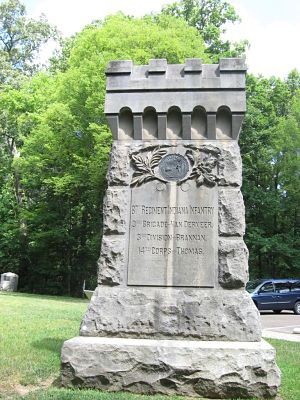
The 87th Regiment is often referred to on the battlefield at Chickamauga National Military Park. This monument to the 87th stands atop Horseshoe Ridge, where the Union made their last desperate stand against the Confederate Army.
The 87th begins the battle with 366 officers and men, only 1/3 of its original strength. By sundown on the second day only 174 men answer roll call. One hundred and ninety-two have become casualties in the 36 hour battle. This 52% casualty rate by the 87th Infantry is the highest of all 28 Indiana regiments who were present at Chickamauga and the eighth highest rate of all 131 Union infantry regiments who were engaged. The 87th and its brigade is one of the last organized units from the Union Army to leave the battlefield.
At some point during the battle Charles is wounded in the left hand by a Rebel ball. He will spend a month in a Chattanooga hospital before going home on furlough. He rejoins his regiment Christmas Day, 1863.
NOV 25 Battle of Missionary Ridge. While Charles is recuperating from his hand wound in Chattanooga his regiment is taking part in a spectacular charge up Missionary Ridge, where the Union Army overruns well-entrenched Confederate positions. The 87th is one of the first to plant its colors on the summit of Missionary Ridge. This is also the battle where Isaiah Wallick is mortally wounded. He dies on November 27, 1863, the day after Thanksgiving.
1864
JAN – APR The 87th Regiment is posted in the Chattanooga/Northern Georgia region preparing for General Sherman’s campaign to take Atlanta.
APR 27 Charles F. Wallick makes his first entry into his new diary (Charles Wallick Diary- CWD). He will faithfully make an addition to it every day for the next year. His entry pattern is always the same. He will enter a daily weather report, acknowledge any receipt of mail and then give a very brief accounting of the day’s activities. He will sometimes mention sending or receiving letters from brother “Bill” (William Wallick) of the 51st Indiana, who is also posted near Chattanooga, TN. The location of Charles' original diary is unknown and probably lost forever. However, a transcript of the diary was type-written by Walter Reyburn sometime after the war. Walter was a second lieutenant in the same company as Charles and had other family connections to the Wallicks. Unfortunately, the transcript was not completed and the entries for July 3rd through December 31, 1864, are not recorded. Only a few portions of the diary's transcript will be presented here so Charles can tell, in his own words, about his experiences during the war. The spelling and grammar have been left unedited in these excerpts. The transcript of Charles Wallick's diary resides in the Miami County Historical Society Museum, Peru, IN.
APR 30 CWD “The night was cold with some rain. The morning was very pleasant...I tried for a pass to go to Chattanooga to see Bill Wallick but failed to get the commanding General to sign it for me. I was very much out of humour all day. My health is very good excepting a very severe cold I caught carelessly. There was a detail sent out of the Division to Nashville after mules for Company and Regimental teams.”
Although Charles did not know it at the time, his pass was denied because all 110,000 men in General Sherman’s Army were getting ready to step off toward Atlanta in a few days. Charles tries to get another pass May 1, but that one is also denied.
MAY 3 CWD “… This day one year ago, Captain Wallick was captured near Rome, Ga. He is now at Chattanooga with his regiment.”
MAY 7 87th begins it’s “March to Atlanta”. CWD “The first thing on docket was to get up about 3 o’clock in the morning and get breakfast, strike tents, pack knapsacks and we moved at seven o’clock. The day was intolerably hot but we marched very steady and rested several times. We camped about one mile southwest from Tunnel Hill. Our troops skirmished here today with the Rebels. Our men fired a shot from the bridge with our cannon. We went into camp about three o’clock a.m. and pitched our tents and took our rest of which we needed.”
Below is Tunnel Hill, near Ringgold, Georgia. It was of strategic important to the Union supply line when General Sherman made his march to Atlanta. Charles camped about one mile from this spot on the evening of May 7, 1864.

Almost daily, for the next four months, there will be skirmishes and engagements with the Confederate Army.
MAY 15 Battle of Resaca. Both Charles F. and “Davies County” Michael are engaged in this battle. In fact, they could have been within a few hundred yards of each other and never have known it. It is also very likely that they didn’t know of each other’s existence due to the great distance between their family branches. Charles’ regiment was placed in the center of the Union line with Michael’s regiment (the 27th Indiana) cattycorner and behind them in support. As the battle progresses Michael and the 27th are moved to the far left of the Union line where they are later engaged in combat. Michael is wounded in the hip in this battle.
CWD- “…The skirmishing began about seven o’clock and our division was in the second line. We moved forward till the balls commenced whistling around us. Our rations were out and we drew here in line of battle and about 11 o’clock we moved forward and our men made a charge. It was the most awful musketry I ever heard and in the evening the cannonading was the hardest. The fight has begun sure.”
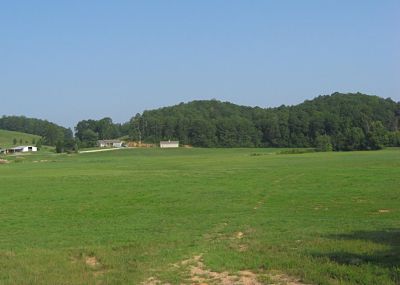
Both Charles F. and Michael Wallick's regiments were on this field during the opening guns at the Battle of Resaca, Georgia. Michael's regiment was later moved to the north where he was wounded in the left hip. Charles and his regiment would have moved from left to right in their charge at the Rebels.
MAY 22 CWD “The morning is very beautiful and the golden sun shines down upon us in all his glory and richness. The mail come this morning but did not bring any news for me. The day past away and we did not move along in the evening. The mail come. The captain received a letter that stated that William was wounded but it was only a report. I do not know whether it is so or not. (in William's complied service record is no mention of him being wounded, but not all wounds were recorded). Our chaplain preached to us today and received good news from the Potomac.”
MAY 25 – JUN 5 Battle of New Hope Church and Allatoona Hills. CWD “The morning was clear and the day was warm. Heavy cannonading was heard along the front this morning. We are now about 30 miles from Atlanta. Our front is about six miles ahead of us. We moved out of camp about 12 o’clock and marched about two miles farther to the front and went into camp for the night. There was heavy skirmishing all day, today. The mail come in but I did not receive anything from the north and the day wore away in all its glory.”
JUN 20 CWD “The morning is very wet and the rain continues to fall. The roads are almost impassable for our teams. There has been more heavy cannonading today than ever I heard before at one time. Our shells would burst on the very top of the mountain (Kennesaw Mt.) The Rebels shell more today than they have since we left Resaca. They have a very strong position here for the artillery. The mail did not come in today. I had my shirt hit today by a ball from a Reb and the day was noisy.”
JUN 27 Battle of Kennesaw Mountain. In order to break the Confederate line in the hills of northern Georgia, General Sherman makes a disastrous frontal assault at Kennesaw Mountain. There are over 2,000 Union casualties verses 500 Confederate. Sherman accomplishes nothing in the process except getting a lot of soldiers killed. He never makes that same mistake again.
CWD “The morning finds us some four miles from where we were yesterday. We moved into position in the rear of the 2nd Division of our Corp. We were hardly in our place when the 2nd Division made a charge on the Rebel works at this point, with what success I am not able to tell yet; but there were several hundred killed and wounded. The day was warm as ever I saw. The majority of our wounded were slightly wounded. Our Division was not in the engagement today. We were held in reserve.”
JUN 29 CWD “The morning was pleasant and the day was very hot. There was a cessation of hostilities today until our men could bury our dead. Our men and the Rebels were all together during the time of the flag of truce. When the time was up, a good many of them deserted and ran and jumped into our entrenchments. Our line of battle is in a stone’s throw of the Rebel’s work. Our works are at the foot of a hill and the Rebels are on the top of it.”
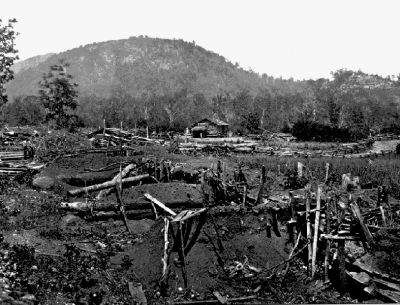
A picture of Little Kennesaw Mountain shortly after the battle. This is the sector where Charles and the 87th Indiana were positioned during the Battle of Kennesaw Mountain.
JUL 2 CWD “The morning was pleasant, the day was hot. The mail come in today. The skirmishing is still going on. We are taking it somewhat easy now. The Rebels say they intend to celebrate the Fourth of July by whipping us out of our works. Let them come on. That is what we want them to try. We think that we will be rid of here and that the Rebels will make a permanent stand here. The weather is dry and the roads are full of dust. Every place that you would go that is so.”
Unfortunately, this was the last diary entry transcribed by Walter Reyburn for the year 1864. Why only half of the transcript was copied is a mystery. We will miss hearing Charles’ first-hand account of Sherman's “March through Georgia” and his “Siege of Atlanta and Savannah.” Charles' diary will continue on Jan 1, 1865.
JUL 19 – 20 Battle of Peach Tree Creek
JUL 22 - AUG 31 Siege of Atlanta & Battle of Jonesboro. The 87th is posted southwest of the city and participates in the Battle of Jonesboro on August 31st..
SEP 2 Surrender of Atlanta
SEP 29 - NOV 3 The 87th Regiment has operations and small engagements with General Hood's Confederate forces in northern Georgia and Alabama.
NOV 15 – DEC 10 Sherman's March to the Sea. Without exception, all the men in Sherman’s army who make the march tell of the wonderful foraging and most of the men say they never ate so well in all their lives. This is, of course, at the expense of the southern civilian population. Commanders try to keep order as best they can during the march but when the stated objective of their mission is to destroy the south’s ability to wage war and make the war come to ALL the southern peoples, not just the armies, things quickly get out of hand. Sherman’s own estimate of property destroyed is put at over 100 million 1864 dollars.
DEC 10 – 21 Siege of Savannah
DEC 25 Christmas Day and Surrender of Savannah. Sherman's Army finally gets new rations, supplies and long awaited mail after being on the march for six weeks through Georgia.
1865
FEB Charles and the 87th begins their march in the "Carolinas Campaign". Sherman's Army causes more mayhem and destruction to the “Cradle of the Rebellion,” South Carolina, than they ever did in Georgia.
JAN 8 CWD “The morning was cold and the day was warm. The mail come in and I received a letter from home. (The day before, Charles says he had not received mail since November 14th, almost two months previous. The March to the Sea and Siege of Savannah had put them out of touch with mail and supplies since leaving Atlanta.). The folks were all well. Bill (brother William) was out of the service, his time was out. My health is very good and the diarrhea has come back on me but is not very bad and does not hurt me as it did before. The time goes very slow. My old watch is not running, the matter is it is so dirty it can’t run.”
FEB 15 CWD “The morning was cold and wet, the day was cloudy. We march at 7 o’clock and on the way we saw a man that had been accidentally shot. We passed over a very hilly and rugged country. The road was downhill all the day long. We marched all day very hard and went into camp after dark. We drew rations, one day’s rations to do three days. The forage is plenty, we live fat off the country."
FEB 16 CWD “The morning was cold and the day warm. We are train guards yet. Companies C and I went out a foraging and the rest was put along the trains at various points as guards. We passed through a town by the name of Texington. We laid here long enough to get dinner then took up our line of march for Columbia, the capital of this state. We went into camp at about 7 miles from the city. We had all the potatoes we wanted to eat.”
FEB 17 CWD “The morning was cold, the day warm. We marched about ten miles and crossed a river by the name of Saluta and passed by Columbia to the right. The roads were very bad. The country is very hilly and is covered with pine, cedar and oak timber. It is not so sandy here as it was in Georgia. The time passed away very fast with me. I saw more fire since I have been in this state than I ever saw since I have been in the service.”
This last sentence is not surprising. The Union Army torched the South Carolina capital and everywhere they traveled in the state.
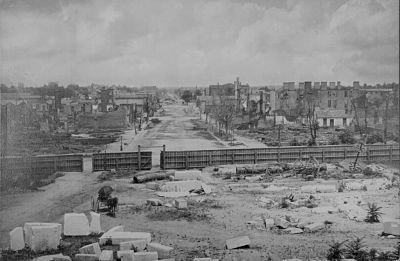
A picture of Columbia, as seen from the State Capitol Building, 1864.
General Sherman placed much of the blame for the war on South Carolina.
MAR 19-21 Battle of Bentonville, North Carolina. The 87th is not engaged in this battle but is ordered to the rear to guard the wagon trains. However, Charles does hear the sounds and sees the effects of the battle. Huette Wallick, son of veteran Michael and distant cousin to Charles, is with the 38th Indiana Infantry and in the front lines at the beginning of the battle. His regiment is eventually forced to retreat and chased off the field by the Rebel Army. Charles and Huette have been in the same army corps since the beginning of the Carolinas Campaign.
MAR 31 CWD “The morning was cool and the day pleasant. The mail come in and I received nothing, nothing as usually. I witnessed a sight today I never wish to see again, that was the shooting of a soldier for inhuman conduct. The court sentenced him to be shot for the third offence. There were a great many lookers on and there was one brigade of infantry formed three sides and he was shot in the center. The boys did not like to see it, although it may be for the best. It is not for me to decide.”
APR 12 CWD “We received a dispatch from Grant that Lee had surrendered his whole force to him. (The surrender happened April 9th). We marched about 14 miles and went into camp for the night. We’re within 13 miles of Raleigh (North Carolina). The time goes fast.”
APR 18 CWD “We laid in camp. Company C went out foraging. They brought in all the sweet potatoes we wanted to use and sorgum molasses also and other things. We received the orders that President Lincoln had been assassinated in a theater and other officials had been fixed upon for the same.”
This is the last entry transcribed from Charles' diary.
APR 26 Surrender of the Confederate Army. Confederate General Joseph Johnston surrenders to General Sherman at the Bennett House in Durham, N.C. Two weeks earlier General Lee surrendered the Army of Northern Virginia to General Grant. This Confederate Army of the Carolinas, Georgia, and Florida is the largest Rebel force in the field and Johnston surrenders over 89,000 soldiers. It is the largest surrender of soldiers during the Civil War. Charles and the 87th Regiment are with General Sherman's Army during this event.
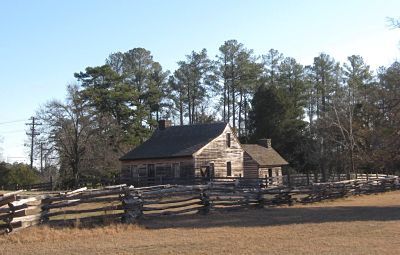
Bennet House, site of the largest Confederate surrender of the Civil War.
This surrender effectively ends the "War of the Rebellion".
APR 29 – MAY 19 The 87th marches to Washington D.C. via Richmond, VA.
MAY 24 Grand Review of General Sherman’s 65,000 men Army of the West in Washington D.C.
Excerpt from A Stupendous Effort, The 87th Indiana In The War Of The Rebellion by Jack K.Overmyer:
“Marching 12 abreast (down Pennsylvania Ave.), it took more than six hours for them to pass the White House reviewing stand before President Johnson, Lt. General Ulysses S. Grant and other dignitaries. The 87th Indiana’s turn came about noon and its Hoosiers never forgot the magnificence and the thrill of the sight that greeted them as they wheeled about the Capital and looked down the long, broad avenue, endless troops, marching curb-to-curb to the rhythm of the martial music, their bright uniforms and muskets glistening in the sunshine. It was a moment to savor for the rest of their lives.”

Washington D.C. May 24, 1865
Both Charles F. and Huette Wallick are part of this grand pageant.
JUN 21 Charles is mustered out of Federal service at a formal military ceremony on the State Capitol grounds in Indianapolis, IN.
Charles F. Wallick returned home to Peru, Indiana and began working for the railroad. On November 10, 1876, he married Lucy A. Search and the couple had three children. He became an invalid late in life and was moved to the Soldiers Home in Lafayette, Indiana in late December of 1903. He struggled with many health issues there until he died on March 3, 1904 with Lucy at his side.
Obituary for Charles Fletcher Wallick

Comrades-in-Arms
Brothers
William 51st IN
John Wesley 138th IN, 151st IN
Uncle
Wesley 109th IN, 138th IN
Cousins
Benjamin 162nd OH
William F. 13th IN, 109th, 151st
 This modest headstone reads:
This modest headstone reads:
Corp'l
C. F. Wallick
Co. C
87th IND. INF.
Charles F. Wallick's grave can be found in the Reyburn Cemetery, Peru, Indiana. He is buried near his parents, Benjamin and Elizabeth, and brothers, William and John Wesley.
Song- Marching Through Georgia
This spirited song was chosen for Charles F. Wallick because he was the only Wallick soldier to actually make the march through Georgia in the fall of 1864.
Return to Top
Return to
Wallick Family Website
